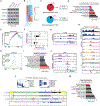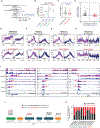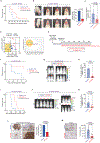Epigenetically defined therapeutic targeting in H3.3G34R/V high-grade gliomas
- PMID: 34644147
- PMCID: PMC8783551
- DOI: 10.1126/scitranslmed.abf7860
Epigenetically defined therapeutic targeting in H3.3G34R/V high-grade gliomas
Abstract
High-grade gliomas with arginine or valine substitutions of the histone H3.3 glycine-34 residue (H3.3G34R/V) carry a dismal prognosis, and current treatments, including radiotherapy and chemotherapy, are not curative. Because H3.3G34R/V mutations reprogram epigenetic modifications, we undertook a comprehensive epigenetic approach using ChIP sequencing and ChromHMM computational analysis to define therapeutic dependencies in H3.3G34R/V gliomas. Our analyses revealed a convergence of epigenetic alterations, including (i) activating epigenetic modifications on histone H3 lysine (K) residues such as H3K36 trimethylation (H3K36me3), H3K27 acetylation (H3K27ac), and H3K4 trimethylation (H3K4me3); (ii) DNA promoter hypomethylation; and (iii) redistribution of repressive histone H3K27 trimethylation (H3K27me3) to intergenic regions at the leukemia inhibitory factor (LIF) locus to drive increased LIF abundance and secretion by H3.3G34R/V cells. LIF activated signal transducer and activator of transcription 3 (STAT3) signaling in an autocrine/paracrine manner to promote survival of H3.3G34R/V glioma cells. Moreover, immunohistochemistry and single-cell RNA sequencing from H3.3G34R/V patient tumors revealed high STAT3 protein and RNA expression, respectively, in tumor cells with both inter- and intratumor heterogeneity. We targeted STAT3 using a blood-brain barrier–penetrable small-molecule inhibitor, WP1066, currently in clinical trials for adult gliomas. WP1066 treatment resulted in H3.3G34R/V tumor cell toxicity in vitro and tumor suppression in preclinical mouse models established with KNS42 cells, SJ-HGGx42-c cells, or in utero electroporation techniques. Our studies identify the LIF/STAT3 pathway as a key epigenetically driven and druggable vulnerability in H3.3G34R/V gliomas. This finding could inform development of targeted, combination therapies for these lethal brain tumors.
Conflict of interest statement
Figures






References
-
- Jones C, Karajannis MA, Jones DTW, Kieran MW, Monje M, Baker SJ, Becher OJ, Cho YJ, Gupta N, Hawkins C, Hargrave D, Haas-Kogan DA, Jabado N, Li XN, Mueller S, Nicolaides T, Packer RJ, Persson AI, Phillips JJ, Simonds EF, Stafford JM, Tang Y, Pfister SM, Weiss WA, Pediatric high-grade glioma: biologically and clinically in need of new thinking. Neuro Oncol 19, 153–161 (2017). - PMC - PubMed
-
- Khazaei S, De Jay N, Deshmukh S, Hendrikse LD, Jawhar W, Chen CC, Mikael LG, Faury D, Marchione DM, Lanoix J, Bonneil E, Ishii T, Jain SU, Rossokhata K, Sihota TS, Eveleigh R, Lisi V, Harutyunyan AS, Jung S, Karamchandani J, Dickson BC, Turcotte R, Wunder JS, Thibault P, Lewis PW, Garcia BA, Mack SC, Taylor MD, Garzia L, Kleinman CL, Jabado N, H3.3G34W promotes growth and impedes differentiation of osteoblast-like mesenchymal progenitors in Giant Cell Tumour of Bone. Cancer Discov, (2020). - PMC - PubMed
-
- Lu C, Jain SU, Hoelper D, Bechet D, Molden RC, Ran L, Murphy D, Venneti S, Hameed M, Pawel BR, Wunder JS, Dickson BC, Lundgren SM, Jani KS, De Jay N, Papillon-Cavanagh S, Andrulis IL, Sawyer SL, Grynspan D, Turcotte RE, Nadaf J, Fahiminiyah S, Muir TW, Majewski J, Thompson CB, Chi P, Garcia BA, Allis CD, Jabado N, Lewis PW, Histone H3K36 mutations promote sarcomagenesis through altered histone methylation landscape. Science 352, 844–849 (2016). - PMC - PubMed
Publication types
MeSH terms
Substances
Grants and funding
LinkOut - more resources
Full Text Sources
Medical
Miscellaneous

